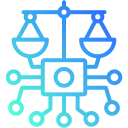The Role of Ethics in Autonomous Systems and AI
Autonomous systems and artificial intelligence are rapidly transforming our world, introducing new levels of efficiency, decision-making, and automation. However, as these technologies become increasingly embedded in society, their development and deployment raise complex ethical questions. From the way AI interacts with data to decisions made by autonomous vehicles, ethical considerations are critical to ensuring safety, transparency, and trustworthiness. This page explores the intricate relationship between ethics and AI, examining the responsibilities faced by developers, companies, and society at large, and highlighting the need for robust ethical frameworks to guide the ongoing evolution of autonomous technologies.

Previous
Next
Foundations of Ethical AI
The definition of ethical AI relies on universally accepted values such as fairness, accountability, and transparency. These values are intended to guide how AI systems make decisions, interact with users, and learn from the vast data they process. To ensure AI is aligned with human values, researchers and engineers embed ethical principles into system design, code, and operational procedures. The challenge lies in translating complex human norms into machine-interpretable rules, often requiring collaboration between ethicists, technologists, and policymakers. Continuous dialogue is essential to ensure these principles adapt alongside technological advancements, preventing unintended consequences and fostering systems that respect societal norms.
Encoding Ethics in Algorithms
Translating ethical concepts into algorithms presents both technical and philosophical challenges. Developers must find ways to encode principles like justice, privacy, or harm reduction into decision-making logic. This often requires navigating trade-offs—for example, between transparency and performance or individual rights and collective benefits. Making these decisions explicit within the system’s code helps promote accountability, but it also introduces the challenge of operationalizing inherently human concepts in mathematically precise language. Algorithmic transparency and explainability are essential to ensuring that decisions made by AI can be evaluated and, when necessary, challenged by affected individuals.
Attribution of Responsibility
The assignment of responsibility in AI is complex, involving not just the creators of systems but also those who deploy, regulate, and use them. When an autonomous system makes an error, determining accountability poses new legal and ethical questions. Does the fault lie with the software developers, the entity deploying the system, or the user? This problem is especially acute in high-stakes areas like autonomous vehicles or healthcare. Clarifying responsibility is crucial to establishing trust in AI and protecting individuals’ rights, and it requires ongoing collaboration between technologists, ethicists, and legal experts to create robust frameworks for responsibility that keep pace with technological change.
Handling Unintended Consequences
No matter how carefully ethical considerations are built into AI, unintended consequences can still arise. Unexpected data correlations, misuse of technology, or emergent behaviors from complex systems can lead to outcomes nobody anticipated. Ethical frameworks must be resilient and flexible, allowing for adaptive responses when things go awry. This includes not only contemplating foreseeable risks but also having mechanisms to detect, report, and rectify unforeseen harm. Cultivating a culture of continual monitoring, review, and improvement ensures that AI systems evolve safely, maintaining their alignment with ethical values over time.
Bias, Fairness, and Social Impact
Origins and Manifestations of Bias
Bias in AI systems can stem from many sources, including skewed training data, flawed sampling strategies, or the unconscious assumptions of designers. These biases may manifest as discrimination in hiring algorithms, racial profiling in law enforcement tools, or unequal access to critical services. The scale and scope of AI mean that subtle biases can have wide-reaching consequences, reinforcing existing structures of inequality. Addressing these issues requires rigorous testing, diversification of data sources, and transparent evaluation criteria. Ultimately, fighting bias in AI is an ongoing process that demands vigilance, empathy, and commitment from all participants in the AI ecosystem.
Pursuing Fairness in AI
Fairness in AI is a complex, context-dependent concept that demands careful deliberation. What constitutes fairness may differ across cultures, industries, and applications, and balancing competing notions can be challenging. It is not enough to simply remove obvious instances of bias—developers must proactively seek input from diverse stakeholders and consider systemic inequalities that may be perpetuated or amplified by AI. Fair AI systems should be designed to foster equal opportunity, protect vulnerable populations, and ensure that benefits and burdens are equitably distributed. Achieving these goals requires the integration of fairness as a core metric in AI development, evaluation, and governance processes.
Social Consequences and Stakeholder Engagement
The impacts of AI extend beyond individual interactions, shaping broad social trends and affecting the structure of communities. The deployment of autonomous systems can influence employment patterns, alter social dynamics, or even challenge concepts of agency and autonomy. Engaging with affected stakeholders—from employees and consumers to advocacy groups and policy makers—is essential for understanding and addressing the broader ramifications of AI. Active stakeholder engagement fosters trust, facilitates the identification of emerging ethical concerns, and helps build resilient policies that respond to society’s evolving needs and expectations.
